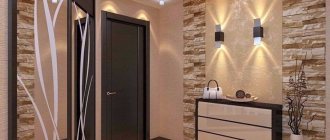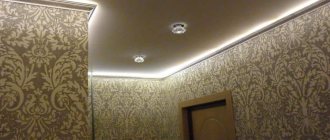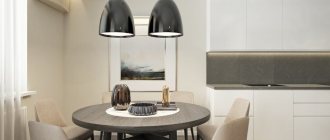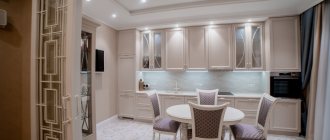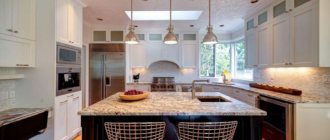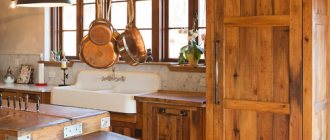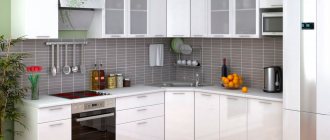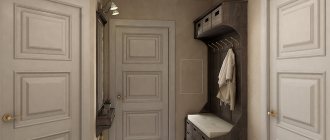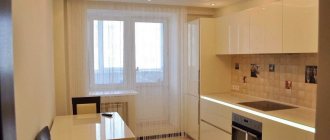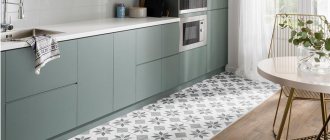Proper lighting is important in the kitchen. It will help with washing dishes or cooking, and will create the right mood for a family celebration or evening in a friendly company. In this article we will look in detail at how to create aesthetic and functional lighting in a kitchen with a suspended ceiling. Let's consider the types of lighting fixtures, as well as methods for zoning space and even the possibility of correcting some design flaws.
General recommendations for kitchen lighting
In this room you should not hang chandeliers that are difficult to maintain - with pendants, protrusions, etc. It is better to stick to lampshades of a simple shape, from which dirt and grease deposits can be easily removed.
The brightness should be sufficient, but not excessive. The cooking zone will require about 100 W per square meter, the dining area - 50 W. For LED lighting devices, this figure is reduced by approximately 80%.
During the planning stage, you need to consider how different surfaces reflect light. With a glossy ceiling, mirrored cabinet doors, and pastel finishing colors, you will need fewer appliances. And if the kitchen has matte linen and furniture or a lot of dark colors, it needs to be better lit.
In the area of the working surface, devices are placed so that they are not blocked by the backs and heads of people. Then there will be no shadow on the table. A suitable distance is 40-50 cm from the wall.
It is better to install light bulbs in a waterproof housing near the sink and stove. But even in this case, the distance to the source should be at least 60 cm.
For a comfortable feeling, you need to take into account the color temperature (measured in Kelvin). Lighting can be:
- warm, yellowish (4000-5000 K), makes the room more comfortable;
- cold, bluish (400-2500 K), used only in offices;
- neutral, reminiscent of daytime (average temperature values), is more suitable for cramped kitchens, as it expands the space.
When choosing light bulbs, you need to make sure that they are approximately the same range, then the overall picture is perceived more harmoniously, and the eyes do not strain. The permissible difference is no more than 500 K.
Advantages and disadvantages
Stretch ceilings are a modern solution, so some are still skeptical about them. They are often attributed to shortcomings that arose solely due to poor installation. If such a product is installed correctly, it will not only look beautiful and stylish, but will also have a number of significant advantages that can make life easier for everyone in the household.
- Stretch ceilings are made of environmentally friendly material.
- Do not attract dust and allow the appearance of fungi and various microorganisms.
- They are highly resistant to fire, making them ideal for the kitchen, especially if your home uses a gas oven.
- If handled with care, they can last for over twenty years while retaining their color.
- They adapt to any interior thanks to the ability to choose the appropriate color and texture.
Moreover, it is no more difficult to care for a suspended ceiling than for windows - the surface gets dirty very slowly and is easy to clean if necessary. A large number of positive qualities and ease of care instill confidence in stretch models for many housewives.
Despite the impressive list of advantages, stretch fabrics also have minor disadvantages:
- If there are temperature differences in the gap between the ceiling and the stretched fabric, swelling may appear on the surface. To avoid them, you should carefully prepare the ceiling before installation and make sure there are no gaps or cracks.
- The height of the room occupies a minimum of 5-10 cm.
- High-quality European and domestic ceilings are produced with a limited width; joints are often used to cover the entire room. The seam is the most sensitive part of the fabric and is most susceptible to damage.
- If a gas stove is used in the house, the cooking process becomes more complicated due to the large increase in room temperature. In the cold season, this deficiency can be compensated by using a half-open window, but in the summer it will be difficult without air conditioning.
Each of these shortcomings is fully compensated for during operation, so a suspended ceiling can be an excellent choice for any modern kitchen.
Classic types of lighting
These options have been known for quite some time, but have not lost their advantages. Suitable for both traditional and more modern designs.
Chandelier
Before installing a stretch ceiling, you need to decide on the location and type of fastening of the chandelier. The film and fabric used as a canvas are elastic and fragile, so all lighting fixtures are attached to the base.
Chandeliers are divided into pendant (mounted on a hook) and overhead (you will need a platform to which the bar is screwed). The first option is usually more massive and elongated.
Select a central point for placement. To determine it, draw diagonal lines from opposite corners. The intersection point is the middle of the ceiling. In this case, you need to take into account the furniture set, i.e. determine the center of the free space. Otherwise, it will seem that the lamp is hanging out of place.
In large kitchens, it is permissible to move the chandelier and hang it above the dining group or island. If the room is elongated, hang two or more identical devices in a row.
All types of light bulbs are suitable, but some have a power limit: 60 W for incandescent lamps and 40 W for halogen lamps. If the temperature rises too high, the film melts and turns yellow. For the same reason, you need to make sure that the metal base does not heat up too much.
Depending on the size of the kitchen, a model with one or more lampshades is suitable. If they are directed upwards, you need to monitor the distance to the ceiling. To prevent the film from overheating, keep it at 15-20 cm.
Note! Light directed upward does not go well with a glossy surface. It will reflect and glare. It is better to choose horns that look down or to the sides, or a model with closed shades.
Spotlights
They can be used both in addition to the chandelier and separately. In the first case, they are placed around the perimeter or along the working area.
As the main lighting, they are evenly distributed across the ceiling. Spot devices produce a narrow beam of light, so the distance between them should be small. Each is enough for about 1-2 square meters.
By design, lamps are divided into:
- built-in (hidden behind the ceiling, the lower part is flush with the surface, usually round or square in shape);
- overlays (the body is visible from the outside; there are round, square, rectangular, cylindrical, with decorative overlays, crystal pendants, etc.).
For a two-level stretch ceiling in the kitchen, it is better to use built-in lamps. They crash into the lower tier of the structure.
Some models have a rotating mechanism that directs the light flux in the desired direction. Such options are called spots.
Important! Like chandeliers with a strip, the lamps are mounted on prepared mortgages, which are mounted before the canvas is stretched. Because of this, it is necessary to decide on the lighting scheme in advance, before installing the ceiling.
Spotlights use different types of bulbs, but LEDs are the most popular. They are economical to consume and last a very long time.
How to position?
The type of arrangement of lamps on the suspended ceiling of the kitchen depends on the tasks you set and your aesthetic preferences.
Central
In this case we are talking about chandeliers, whose power is enough to illuminate almost the entire kitchen.
Along the perimeter
A strict scheme in which ceiling lamps are placed sequentially throughout the room, and the role of the central lighting device is played by a classic chandelier.
Symmetrical
A classic type of arrangement for a kitchen with geometrically adjusted corners. Especially recommended if you tend to have a strict style.
Asymmetrical
It becomes increasingly relevant for rooms with a non-trivial design. It fulfills not only an aesthetic, but also a practical task: the offset allows you to highlight specific areas that need it.
Circular
Allows you to create a non-standard light pattern and create a unique mood. Indispensable if the interior of your kitchen has roundness.
Modern technologies in lighting
Let's consider non-standard lighting options, which are only possible when installing a stretch ceiling. These design ideas will transform the interior and create a “zest” in it.
Glowing ceiling
For such an unusual option, you will need a translucent film. It is mounted at a distance from the ceiling, and diodes are placed in between. A tape in several rows or panels is suitable. After switching on, the canvas diffuses the light, ultimately emanating from the entire ceiling. Usually choose a neutral color temperature - it looks more like the sun's rays.
Peculiarities! You can print an image on the film - for example, the daytime sky or tree branches. This technique visually increases the height of the kitchen.
Sometimes not the entire surface is made translucent, but only a fragment. If it is large enough, this will be enough for full illumination.
Light lines and patterns
This option plays a complementary and decorative role, but can also be used as main lighting. As with the previous method, you will need an LED strip and a diffuser film. But in this case, only the diodes glow, they form lines or patterns. To ensure that the light does not spread to the sides, but is directed downwards, the LED strip is placed in special baguettes. Profiles can be cut and bent, connected at right or acute angles, etc.
When the tape is laid, stretch the film. While the lighting is not working, the ceiling looks like an ordinary stretch ceiling. And when turned on, luminous patterns or inscriptions appear on the surface. The drawing can be made in color: for this, RGB tape is laid. Usually a remote control is connected to make it more convenient to control brightness and hue.
Contour lighting and floating ceiling
This is another way to use LED strip. It is laid around the perimeter in specially designed profiles and covered with a dissipative insert.
If the strip is hidden behind the canvas, the light will come from between it and the wall. Then the impression will arise that the ceiling is not fixed, but is floating in the air. This technique looks impressive and visually increases the height.
Peculiarities! This lighting goes well with the central chandelier.
To create such a design, special types of profiles are used. The film is stretched at a short distance from the walls. A diode strip is inserted into the resulting gap.
Read more: How to make a floating stretch ceiling
Built-in LED panels
These are large flat lamps, usually round, square or rectangular in shape. Inside there are diodes covered with translucent glass (usually acrylic). The result is light that is soft and comfortable for the eyes.
Such panels are placed evenly on the ceiling surface: in a line, in a checkerboard pattern, making patterns, etc. They are suitable as the main source of lighting.
Spot systems
This is the name of a group of rotating spotlights assembled together. They are mounted on a common rod (track), inside of which the wiring is hidden. The total brightness is enough to use such a system as the main source of lighting.
The rod can be straight, arched, or form a closed loop of any shape. Sometimes they make a bus along which the lamps move freely.
The main advantage of track systems is the ability to direct lighting to the right place. This is the most flexible and variable method.
But there are also disadvantages. This design is not suitable for low ceilings, since the light bulbs are located at some distance from it. In addition, the system does not fit into all styles: it will be most appropriate in a loft, but not at all suitable for a classic one.
Chandelier
This is one of the winning options for decorating a room with a suspended ceiling, the starting point of the entire light composition, which will provide general lighting. True, such a lamp does not look good in a small kitchen, and even with a low ceiling.
Chandeliers decorate not only classic interiors. They are appropriate in the styles of minimalism, hi-tech, retro, Provence, modern and are represented by a wide range of original lamps of regular and irregular shapes. The evidence awaits you in the photo below.
Idea: Want to create a unique ceiling accent? Decorate an inconspicuous chandelier with a fringe of threads, stones, beads, tetrapacks, glass, make shades from paper, wood or clothespins. Use materials that do not deform due to temperature, and remember to weigh the lamp down. Alternatively, first test how your chosen material will react by bringing it closer to the heat source.
The chandelier is placed exactly in the center of the ceiling, but in a spacious kitchen it can be shifted. It depends on the area chosen for lighting and the design of the ceiling. The larger the room, the greater the number of lamps needed for the chandelier. To illuminate a rectangular room or section of the ceiling, an elongated chandelier is suitable, and a round or semicircular tier will be decorated with a lamp of a similar shape.
Important: when planning kitchen lighting on paper or in online programs, find the exact center taking into account the kitchen unit - of course, if you do not plan to rearrange the furniture. Otherwise, it will seem that the chandelier is placed asymmetrically.
Do not forget about the sensitivity of film tension fabrics to heat.
Recommended standards differ for each type of lamp. To avoid damage to the canvas, you can use lamps with frosted glass for the chandelier. Another option to avoid this is to combine suspended ceilings with plasterboard, and install lighting in a more durable material.
Zoning the kitchen with light
There are two main areas in the kitchen: dining and working. The latter sometimes consists of an island and a set against the wall. Typically, different lighting is selected for zones. This way their boundaries are emphasized. In addition, different levels of brightness are required for household chores and friendly or family gatherings.
A chandelier is often hung above the dining group. For a small kitchen, one lampshade is enough. It is convenient if the suspension on which it is mounted is lowered to different heights.
Above the cooking and dishwashing area, lighting is made from spotlights or LED strip. A spot system would look good in the area of the kitchen island. Depending on the size and shape of the table, a round or linear one is suitable. Another option is to place a light strip here.
Spots
Super-functional modern lighting fixtures that can be easily directed to a particular area or object. There are suspended, overhead, built-in ceiling or furniture spots, with industrial, ordinary or sophisticated lampshades. For all this they are valued by designers.
Spots are suitable for huge spaces and kitchens in Khrushchev, and the variety of shapes and models gives them a green light in every interior direction. Decorate the metal crossbar with your own hands, as we advised in the case of the chandelier, and bring the spot closer to soft classic styles.
One such lamp will gently highlight a picture, niche or other accent detail of the interior, and several lamps will illuminate a spacious room.
Spots and spot systems are useful when rearranging furniture, because they will provide the right direction of light for cooking or eating. Examples of spots are waiting for you in the photo.
Adjusting the perception of space
Even the most spacious kitchen looks smaller due to shadows in the corners. Therefore, it is important to provide sufficient lighting levels.
A cramped room will seem larger if you direct the rays at the walls - this way they will seem to move apart. To create this effect, spotlights or a central chandelier with shades directed to the sides are suitable.
With a low ceiling, it is better to abandon options that “eat up” the height even more. Flat panels will do. You can slightly lower the ceiling along the perimeter and install lighting between the levels - the central part will rise.
In a long and narrow room, hang 2-3 small lampshades. The ceiling is divided into segments and does not seem so elongated. Transverse light strips will also help, visually expanding the surface.
Which color to choose
It all depends on how your kitchen is decorated as a whole: the color of the ceiling often echoes the walls or pieces of furniture. The result is a harmonious and harmonious color picture.
If yours is glossy, has a significant amount of usable space, and uses a multi-level design, it makes sense to highlight one of the levels in rich red. Such a bright shade will always set a positive mood. What else is needed for a healthy appetite?
Dark shades work well in tall and spacious rooms. They bring orderliness and nobility to the interior, so they are ideal for classic, restrained designs or a loft prone to industrial motifs.
Shades can and should be combined with each other so that the color landscape of the room is natural and balanced. Too loud colors (green, light green) are diluted with a snow-white surface or universal light beige and cream elements.
Designer tips
Irina
founder of the interior studio, architect and interior designer. The main area of work is kitchen design
When choosing a color, remember that the glossy texture enhances the shade. Matte or satin, on the contrary, muffles. Based on this, you can select an acceptable color intensity and get it, when implemented, exactly as it was intended in your imagination.
Additional lighting
In a small kitchen (for example, in a Khrushchev-era apartment), it is not necessary to hang a chandelier over the dining table. A wall sconce will be enough. This option will also save space in height.
It is useful to add lighting in the cabinets. This makes it more convenient to search for the necessary products or utensils, especially if they turn on automatically when you open the doors. And with a glass facade, additional lighting will appear, emphasizing the beautiful service.
Not an easy idea to implement, but a useful idea - dim lighting near the ceiling. It will help you navigate in the dark. To do this, lay a diode strip or build small point devices into the baseboard.
Other options
The problem of lighting in the kitchen can be solved using not only modern lamps, but also ordinary incandescent lamps . Today they are presented in a wide variety of options and, if desired, you can choose a product for any device. Their main advantages are:
- Low cost.
- Various power . You can find a lamp with a power rating from 20 to 300 W.
If we compare incandescent lamps with other light sources, then in terms of the number of shortcomings, the first ones lose to their competitors:
- High power consumption.
- Short service life.
- Strong heat.
Fluorescent lamps can be used as a lighting and illumination system . This device produces a diffused light flux. Although they are not often used in the kitchen, they have many advantages:
- No overheating.
- The luminous flux created by the lamps resembles the radiation of the sun.
- Large selection of shapes and sizes.
For all their positive qualities, fluorescent lamps have not received proper distribution. The reason for this is their disadvantages - the impossibility of using them on curved structures, high noise during operation, and inconvenience in maintenance.
Photo gallery of ideas
Properly organized lighting in the kitchen is the key to a cozy atmosphere and convenience in household chores. You can create it in different ways, using both classical techniques and more modern developments.
